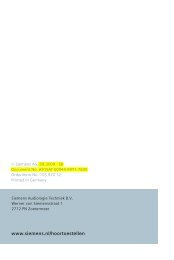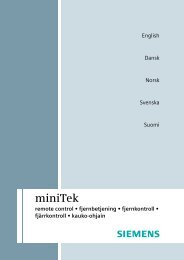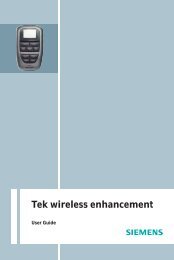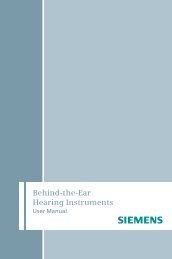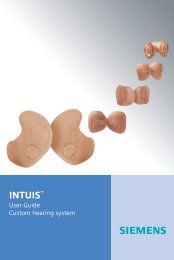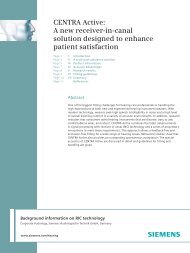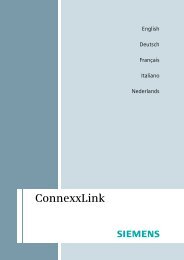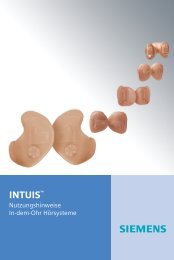Study report SoundSmoothing - Siemens Hearing Instruments
Study report SoundSmoothing - Siemens Hearing Instruments
Study report SoundSmoothing - Siemens Hearing Instruments
You also want an ePaper? Increase the reach of your titles
YUMPU automatically turns print PDFs into web optimized ePapers that Google loves.
Methods<br />
21 hearing-impaired subjects ranging in age from 24<br />
to 85 years, with a median age of 75, participated in<br />
the study. All subjects had a symmetrical sensorineural<br />
hearing loss. The mean three-frequency average<br />
(3FA) hearing loss of the group ranged from 26 to<br />
58 dB HL, with a mean 3FA of 43 dB HL. The subjects<br />
had worn amplification devices from 1.5 to 21 years,<br />
with a mean of 7.5 years. All subjects were fitted<br />
binaurally with CENTRA P BTE housings containing<br />
microphones and receivers. The signal processing<br />
was done in an external computer. The devices were<br />
fitted according to NAL-RP (Byrne et al.1991). Linear<br />
amplification was chosen to separate the effect of<br />
<strong>SoundSmoothing</strong> from other signal processing strategies<br />
that adaptively change gain.<br />
The <strong>SoundSmoothing</strong> algorithm could be disabled or<br />
enabled on three strengths: minimum, medium, and<br />
maximum. The algorithm was evaluated using six<br />
stimuli comprising:<br />
• Speech within two loud, repeated transient<br />
sounds (door slamming and hammering nails)<br />
• Speech within two softer sounds with frequent<br />
amplitude fluctuations (paper rustling and cutlery<br />
clattering)<br />
• Speech within a medium level of stationary<br />
sounds (party noise)<br />
• Speech in quiet surroundings<br />
In a round-robin paired-comparison test, the three<br />
strengths and the “off” condition were compared<br />
five times for speech in the door slamming, paper<br />
rustling and quiet stimuli. For the remaining stimuli<br />
only the medium strength and the ”off” condition<br />
were compared. Each comparison was rated in terms<br />
of preference strength (slightly better, moderately<br />
better, or much better). For each stimulus, the<br />
subjects were asked to indicate what subjective<br />
listening criteria they had used to determine their<br />
preference.<br />
Horizontal localization performance was measured<br />
using the hammering nails noise as stimulus. Horizontal<br />
testing was conducted in an anechoic chamber<br />
with an array of 20 loudspeakers. A 1.5-second<br />
sample of the hammering nails noise was used as<br />
the test stimulus. The subjects were asked to verbally<br />
<strong>report</strong> the perceived direction of the stimuli.<br />
”A strong preference for<br />
<strong>SoundSmoothing</strong> can be seen<br />
for all impulsive noises.“<br />
Speech recognition was measured in the more continuous<br />
paper rustling and cutlery clattering noises.<br />
All three strengths as well as the ”off” condition<br />
were included in these tests. For the speech discrimination<br />
task, the Bamford-Kowal-Bench/Australian<br />
version (BKB/A) Standard Sentence Lists (Bench et al.<br />
1979) were administered.<br />
Prior to testing, the subjects were asked to what extent<br />
they were bothered by sudden sounds in their<br />
everyday lives.<br />
Results<br />
Preference for <strong>SoundSmoothing</strong><br />
For simplification, the results of the various Sound-<br />
Smoothing strengths were combined for each stimuli<br />
– i.e. “on” setting comprises “min”, “med” and “max”.<br />
A strong preference for <strong>SoundSmoothing</strong> can be<br />
seen for all impulsive noises, especially for the loud<br />
and repeated ones (hammering, door slamming).<br />
A two-sided binomial test revealed statistically significant<br />
preference for <strong>SoundSmoothing</strong> “on“ for<br />
hammering (p < 0.001), door slamming (p = 0.007)<br />
and paper rustling (p = 0.002). No preference can<br />
be seen for the stationary party noise and the speech<br />
signals. This is probably due to the fact that<br />
<strong>SoundSmoothing</strong> does not affect these signals and<br />
therefore the subjects did not hear any difference<br />
between the “on” and “off” condition, yet the test<br />
conditions forced the participants to choose between<br />
them. Nevertheless, this is a very positive finding, as<br />
it confirms that <strong>SoundSmoothing</strong> does not cause any<br />
artifacts or interferences that would reduce speech<br />
quality. Generally, the subjects used clarity of speech<br />
as their main listening criterion in the paired comparison<br />
test, although loudness and comfort of noise<br />
rated higher (or equally high) when listening to<br />
speech in the three most transient noises (door slamming,<br />
hammering nails, and cutlery clattering).<br />
Repeated measures ANOVAs on the weighted pairedcomparison<br />
preference scores were calculated for<br />
each stimulus, using grouping of the subjects by how<br />
bothersome they found sudden sounds as the between-subject<br />
variable. These analyses revealed no<br />
significant effect of bothersomeness (p > 0.05). This<br />
indicates that the degree to which sudden sounds<br />
bother subjects in their everyday life is not a good<br />
predictor of whether or not they will prefer Sound-<br />
Smoothing for the stimuli used in the present study.<br />
Horizontal localization<br />
Horizontal localization was tested with the conditions<br />
<strong>SoundSmoothing</strong> “on”, “off” and also with 10<br />
hearing-impaired subjects in an unaided condition<br />
(Keidser et al., 2006). The subjects <strong>report</strong>ed no significant<br />
effect of <strong>SoundSmoothing</strong> on horizontal<br />
localization performance in the left/right dimension<br />
(p = 0.33) or in the front/back dimension (p = 0.44).




